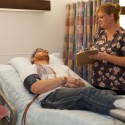Abstinent Alcoholics And Postural Sway
Excessive sway during quiet standing is a common and significant consequence of chronic alcoholism, even after prolonged sobriety, and can lead to fall-related injury and even death. A new study of residual postural instability in alcohol-abstinent men and women shows that alcoholics improve with prolonged sobriety, but the improvement may not fully erase the problem of instability.
Results will be published in the March 2010 issue of Alcoholism: Clinical & Experimental Research and are currently available at Early View.
“Caricatures depict acutely intoxicated individuals with a stumbling, weaving, wobbly gait,” said Edith V. Sullivan, professor in the department of psychiatry and behavioral sciences at Stanford University School of Medicine and corresponding author for the study. “With sobriety, gait and balance become stable. However, even with prolonged sobriety, people with long-term chronic alcohol dependence can have difficulty in standing upright. Their balance can be marked by sway that exceeds what most of us experience while standing still in one place, especially with feet together and hands down by one’s side, that is, without use of natural stabilizing factors.”
Sullivan said that quantifying the sway can be accomplished by using a force plate to record the sway path in fractions of an inch over fractions of seconds during quiet standing. This provides “sway path tracking” as well as measurement of body tremor, which are micro-movements often reflective of central nervous system damage that can be found both in Parkinson’s disease and alcoholism.
Researchers used a “force platform” to measure postural sway – with and without stabilizing conditions from touch, vision and stance – in 34 alcoholic men, 15 alcoholic women, 22 control men, and 29 control women. They then analyzed “biomechanical control mechanisms” that indicate skeletomuscular control over balance, which – under normal circumstances – means the muscles, joints, and skeletal structure are working synergistically, in a give-and-take manner.
“Results show the sway paths of alcoholics are longer and cover a wider area than those of controls for a given time,” said Sullivan. “However, it is important to note that the standing stability of sober alcoholics can be improved by using stabilizing factors. These factors can include simple aids like turning a light on in a dark room, touching a banister while walking down a flight of stairs, or walking or standing with feet apart rather than with ankles close together.”
Sullivan added that the disproportionately greater sway in the anterior-posterior (front-to-back) direction than the medial-lateral (side-to-side) direction that they found is associated with chronic alcoholism as well as pathology of the anterior superior vermis of the cerebellum.
“This part of the brain is often disturbed in alcoholism, and lesions there, whether or not a result of alcoholism, can cause impairment in gait and balance,” she said. “It is interesting to note that while alcoholic men and women can quell their imbalance with stabilizing factors, alcoholic women do not necessarily improve to control levels.” Until more is known about improving this deficit, Sullivan suggested that people who are at risk utilized simple strategies to stabilize balance and to avert falls.
source: Medilexicon
